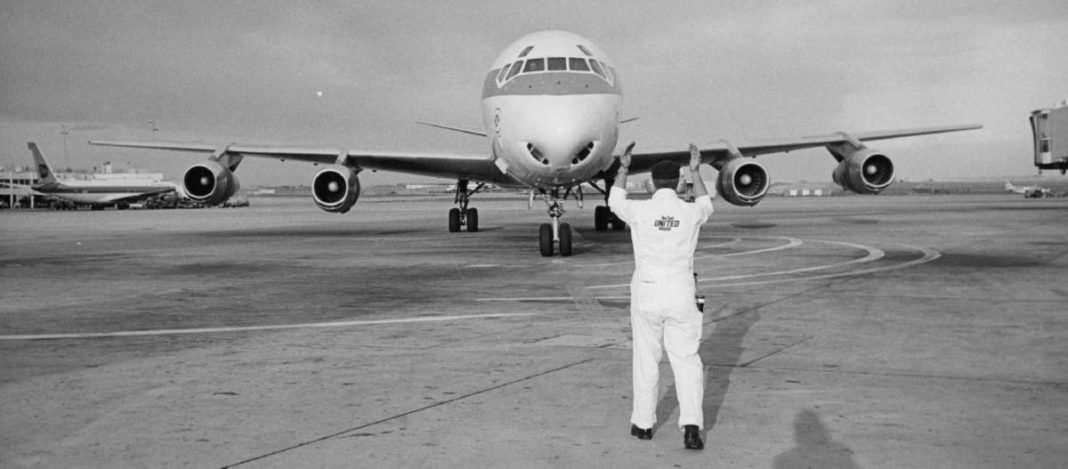Last month, we covered how the Douglas DC-8 helped Delta Air Lines enter into the jet age in the late 1950s. However, the narrowbody also played an essential part in United Airlines’ growth during this critical time in aviation history.

A change of scene
The jet engine was considerably reducing flight times for companies that took it on. Primarily, the introduction of Pan American’s Boeing 707-120 on August 15th, 1958, took the US market by storm. It was the first commercial jet aircraft to be delivered in the country. Subsequently, on October 26th of that year, the carrier launched the first 707 passenger operation and the first daily transatlantic jet service from New York to Paris.
However, behind the scenes, United was making movements to keep up with its competition in the jet race. According to Yesterday’s Airlines, the Chicago-based carrier was influential in the development process of the DC-8 from an early stage. It informed the manufacturer what it was after in its first jetliners.
Notably, the airline’s president, William A. ‘Pat’ Patterson, was a supporter of a six-abreast seating layout. His requests were then taken into account in designing the plane’s cross-section.
The original model was part of the 10 series. This plane was powered by four Pratt & Whitney JT3C turbine engines, which helped it reach cruise speeds of over 600 mph (966 km/h). It also had a range of 3,760 nmi (6,960 km). During testing, it became the first form of commercial transport to break the sound barrier.
Head-to-head
United was the launch customer for the DC-8. The first unit that arrived with the airline was registration N8004U, which was the eighth one ever built. It was given the nickname of Mainliner Capt R T Freng, and United took control of it on June 3rd, 1959.
Over the next three months, five more units joined United for training purposes. However, the operator took its time to deploy the jet for passenger services. Despite being the first to receive the type, it entered it into service on the same day as Delta.
United’s first-ever jet service was on September 18th, 1959. Its DC-8 performed a transcontinental operation between San Francisco New York Idlewild. Due to both flights being conducted in different time zones, Delta’s trip to Atlanta from New York is in the record books as the first DC-8 passenger service.
Nonetheless, both carriers would have been ecstatic with the progress made. They were able to cut flying times between major cities by up to 40 percent. Moreover, they could carry nearly twice the amount of passengers and cargo than the larger piston-engine planes of the time. In a single class setting, 177 customers could fit on these original DC-8s.
A diverse holding
By the end of the year, United took on 16 units of the type. For many passengers of the airline, the first time they traveled on a jet service would have been with the DC-8. Of the original 19 units built in 1959, 18 were series 11s. However, there was one unit that was part of the series 12 program. This plane was registration N8018U and marked the time that the aircraft leveled up as part of United’s fleet when it arrived in February 1960.
Altogether, there were seven series of the DC-8. United held six variants, but several units were upgrades of its existing units.
According to Planespotters.net, United’s 177 DC-8s were divided by the following at the point of exit:
- Two Series 10s
- 30 Series 20s
- 11 Series 30s
- 33 Series 50s
- 41 Series 60/70s
The DC-8-71 was a modernized version of the DC-8-61. It featured a low-noise, advanced technology CFM56 engine.

United would go on to perform operations with DC-8 for over three decades. However, the relationship was never as strong since the Airline Deregulation Act of 1978. The changing market caused a new cutthroat environment. Therefore, carriers needed to be more efficient than ever if they wanted to compete with new players on the scene.
Additionally, 1978 was the same year that United Airlines Flight 173 crashed near Portland International Airport. The incident resulted in ten fatalities.

Time to say goodbye
Subsequently, the story of United’s DC-8s ended with the arrival of the 1990s. According to UPI, the airline announced that the final revenue flight would be on October 31st, 1991. This service left the Hawaiian island of Kona at 14:35 to head for San Francisco. This was a fitting destination for the jet as the Californian city played a part in its first-ever service with the carrier.
The plane’s younger sibling, the DC-10, took over this Pacific operation. Additionally, by the time of this final call, most DC-8 routes had already been replaced with the Boeing 757-200.
United had upgraded to the DC-8-71 by the time of this retirement. This model could serve 200 passengers. The 757 held 194 seats, which were fewer than what its counterpart offered, but its two engines were cheaper to operate than the four-engine jet. On average, the 757-200 burned 655 fewer gallons of jet fuel per flight hour than the DC-8-71.

Ultimately, the DC-8 may not be remembered as the most powerful jet, but it was the plane that started it all for United. The airline would go on to leave a lasting legacy in the aviation industry and is still one of the major carriers in the US and the world today.
What are your thoughts about United Airlines’ DC-8 aircraft? Do you have any fond memories traveling on the jet over the years? Let us know what you think of the plane in the comment section.
[ad_2]
Source link



